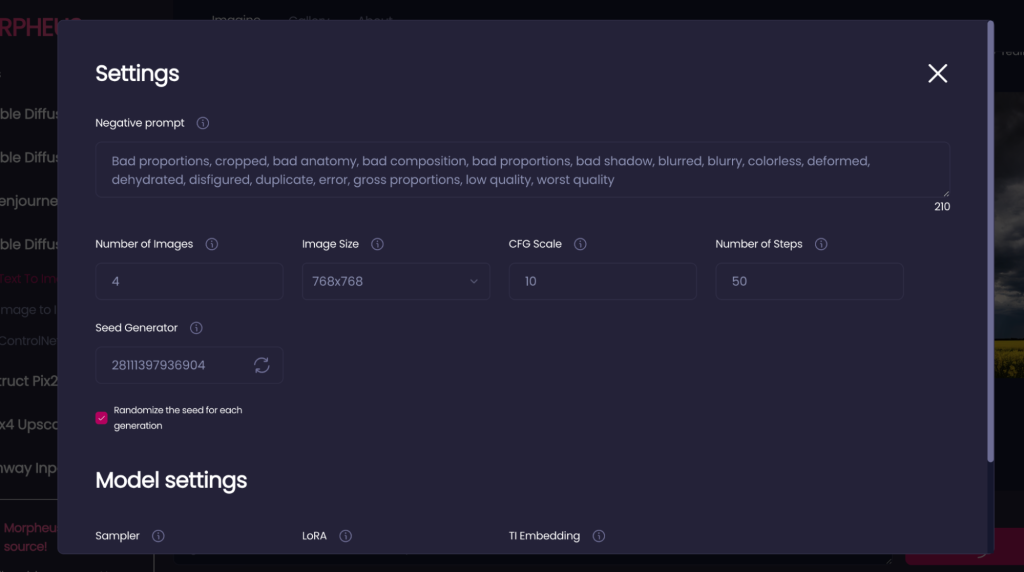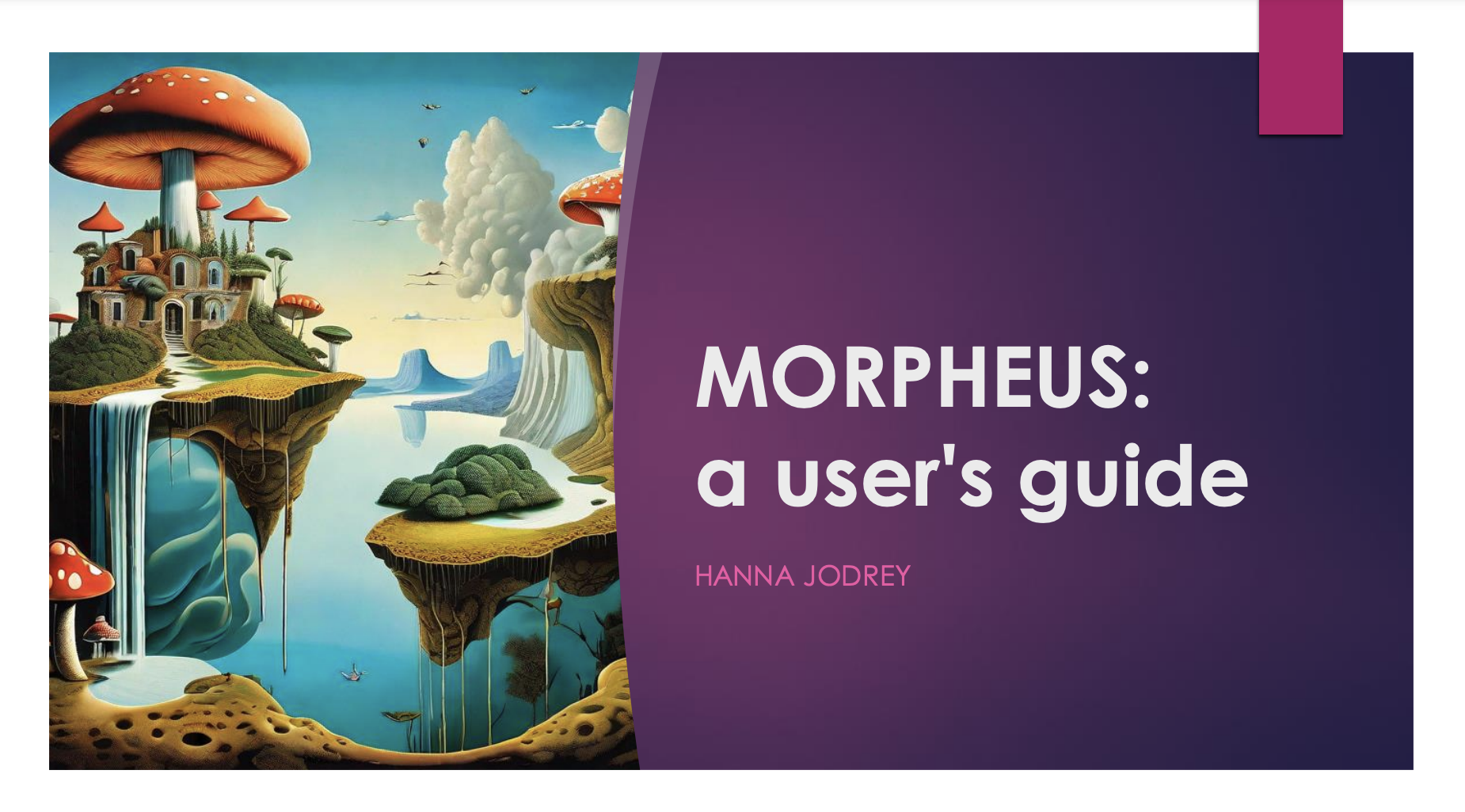18 Generating Images with Morpheus AI to Enhance Learning Outcomes and Inspire Creativity
Hanna Jodrey

Image created with Morpheus image generator.
Prompt: A dog sits under a beautiful, intricate tree. Full moon, starry sky, illustrated border, whimsical.
Introduction: Bridging Art and Artificial Intelligence
In this chapter, we look at Morpheus, an open-source AI art generation tool. We’ll explore its multiple capabilities and will highlight Morpheus’s potential to foster creativity among learners across a wide range of educational contexts, as well as its potential to foster collaboration and cooperation among its users.
Morpheus seeks to provide a user-friendly experience for people who are new to experimenting with AI art generation, and as such, was built to be flexible and easily navigable.
As we investigate its architecture, affordances, and integration into curricula, we’ll also examine how the basic principles of Morpheus can be applied to other generative art tools.
Critical Media Literacy: Fostering Creativity, Continuous Learning, and Critical Thinking
Let’s take a closer look at how Morpheus can be utilized to meet educational outcomes and enhance curriculum objectives. Note that the educational context was left purposefully vague to better accommodate the widest range of contexts possible using this tool.
- Exploring the relationship between language and visual representation: Morpheus can be used to help students understand how different adjectives, nouns, or even adverbs alter the artwork. For example, according to Lee, Kim, and Sung (2023), students can generate artwork based on specific adjectives or nouns, and then compare and contrast the different pieces to identify patterns and themes.
- Encouraging creativity: Morpheus can encourage creativity by providing a new way of thinking about art and design. They can help students explore new ideas and concepts that they may not have considered before. For example, students can use AI art generators to generate artwork based on a specific theme or prompt, and then use that artwork as inspiration for their own creative writing (Ditch that Textbook, n.d.). Morpheus can also provide a new medium for artistic expression, allowing students to create unique pieces that would be difficult or impossible to create using traditional techniques.
- Preparing students for the future: As AI technology continues to advance, it is becoming increasingly important for students to learn how to work with these tools. By incorporating AI art generators such as Morpheus into their curriculum, educators can help prepare students for the future job market.
Morpheus can also be used to help develop students’ critical thinking and media literacy skills. Image modification (digital editing, etc.) is nothing new, and this will continue to be the case as AI image generation tools become more and more prevalent. However, by gaining experience and familiarity with AI image generation through Morpheus, learners will become more adept at recognizing that many images presented as real or factual depictions of events or situations may in fact be modified. As they develop this awareness, they will consequently refine their critical thinking skills and media literacy by critically evaluating the images they encounter.
Furthermore, Morpheus can also aid in the important process of democratizing AI. Currently, many people are intimidated by generative art; they may not know how to use the tools or they fear that these tools will come to replace the work of human artists. However, having a basic understanding and ability to use these tools will enhance their artistic skills, confidence, and adaptability. In that spirit, Morpheus stands to become a powerful tool for democratizing AI, by extending accessibility to learners across the spectrum.

Affordances and Constraints
Affordances: Unleashing Creative Potential
- User-Friendly Interface: Morpheus is user-friendly, making it an ideal starting point for those venturing into AI-generated art for the first time. Its intuitively designed interface accommodates users with varying technical proficiency, dismantling entry barriers.
- Diverse Generative Models: Among Morpheus’s notable features is its wide array of generative models, including Stable Diffusion v1, v2, XL, and Openjourney. This diverse selection encourages users to switch between models and experiment with a broad palette of artistic possibilities.
- Artistic Customization: With customizable options like modifying text prompts, altering existing images, and selecting distinct art styles, Morpheus provides the tools to create personalized artworks.
- Collaborative Features: Morpheus strives to cultivate a sense of community and collaboration through its integrated collaborative painting system. This feature transforms the creative process into a communal endeavour. Users can engage in real-time collaboration, sketching, ideation, and iteration with fellow creators.
- Private Image Gallery: Morpheus offers a private image gallery where users can confidently store and organize their artworks within this protected space, thereby safeguarding their creative endeavors.
Constraints: Navigating Challenges
- Learning Curve: Despite Morpheus’s user-friendly design, novices to generative art and AI concepts may encounter a learning curve. Leveraging the tool’s full potential may demand an initial investment of time and exploration.
- Model Limitations: Morpheus offers an impressive array of generative models, but users should acknowledge the tool’s limitations. Highly complex or narrowly specific art styles may pose challenges. The generated output may fluctuate based on the chosen model, so users should explore different models to see what best aligns with their objectives.
- Data Privacy: Users should exercise discretion when uploading images to Morpheus, recognizing that the tool stores these images on an AWS S3 bucket. While Morpheus ensures a private image gallery, responsible data privacy and security practices are imperative. Grasping how data is managed within the tool becomes pivotal in safeguarding artistic content.
- Resource Requirements: While Morpheus simplifies many technical aspects, users should remain mindful of potential resource demands, particularly for resource-intensive tasks or large-scale projects. Processing complex generative models may require substantial computational resources. Users should assess their hardware capabilities and allocate resources judiciously.
THE PROCESS
- Accessing Morpheus: Start with accessing the tool’s WebUI. Sign up for a free account or use Google.
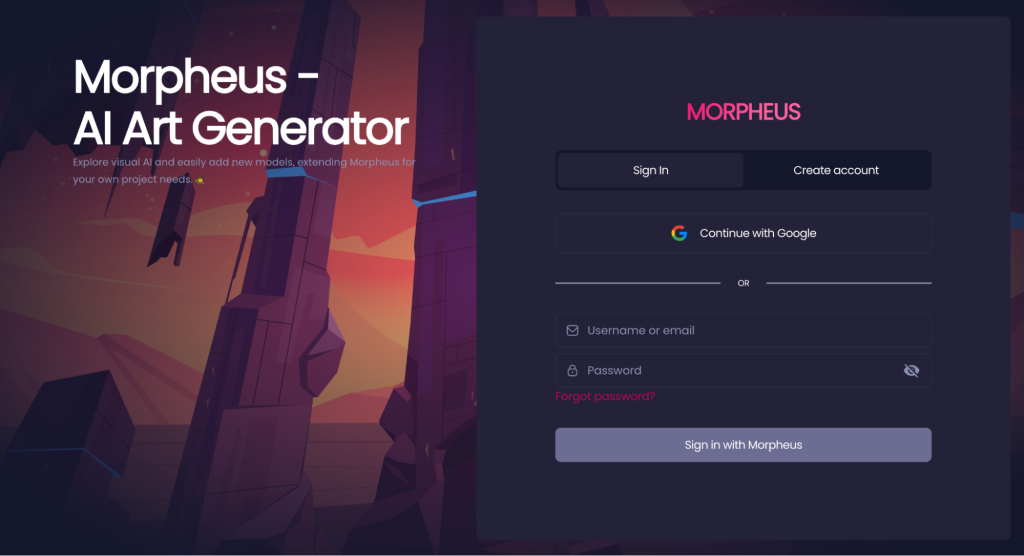
- Navigating the UI: Upon entering Morpheus, you’ll encounter a user-friendly interface that offers clear navigation options.
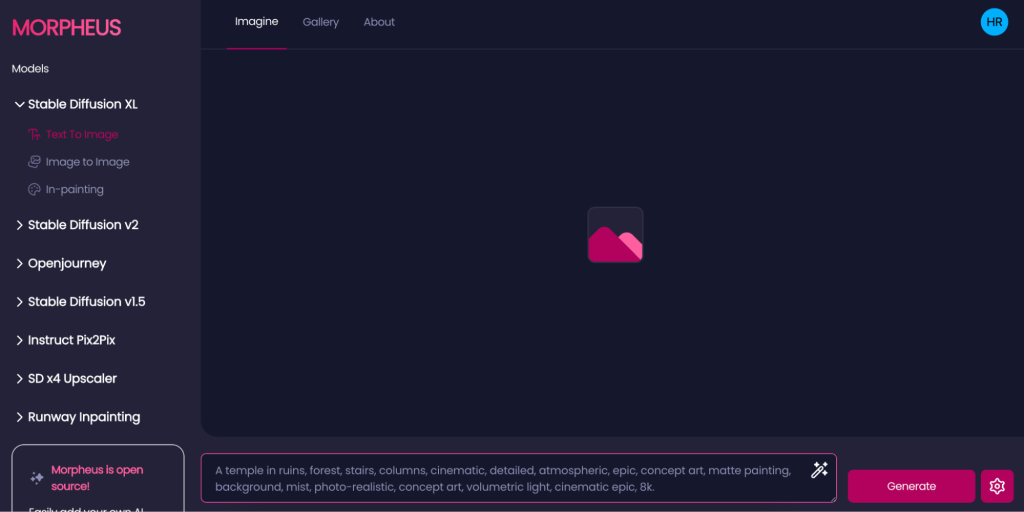
- Choosing a Generative Model: Morpheus offers a selection of generative models (in the menu on the left), each with its unique characteristics. The user selects the model that aligns best with their creative vision.
- Creating Art Based on Text Prompts: By entering a descriptive text that conveys the desired image, Morpheus leverages the selected model to generate artwork.
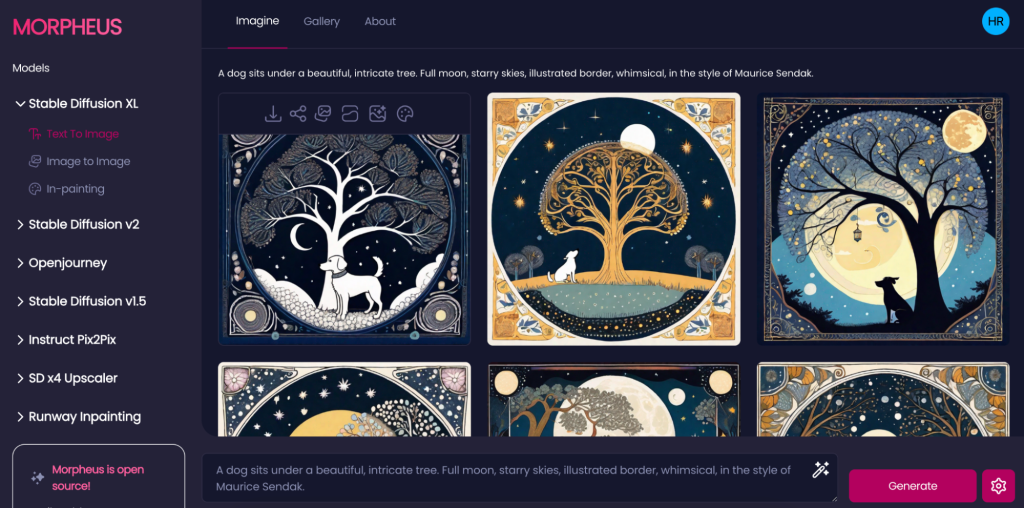
- Modifying Existing Images: Morpheus is able to enhance or transform pre-existing images. Users upload their images and describe the changes they wish to see. Morpheus uses these text prompts to modify the uploaded image accordingly.
- Collaborative Painting: The integrated collaborative painting system allows the user to make initial sketches of the desired images. In an online editor, they can also collaborate with other users to create a collaborative painting.
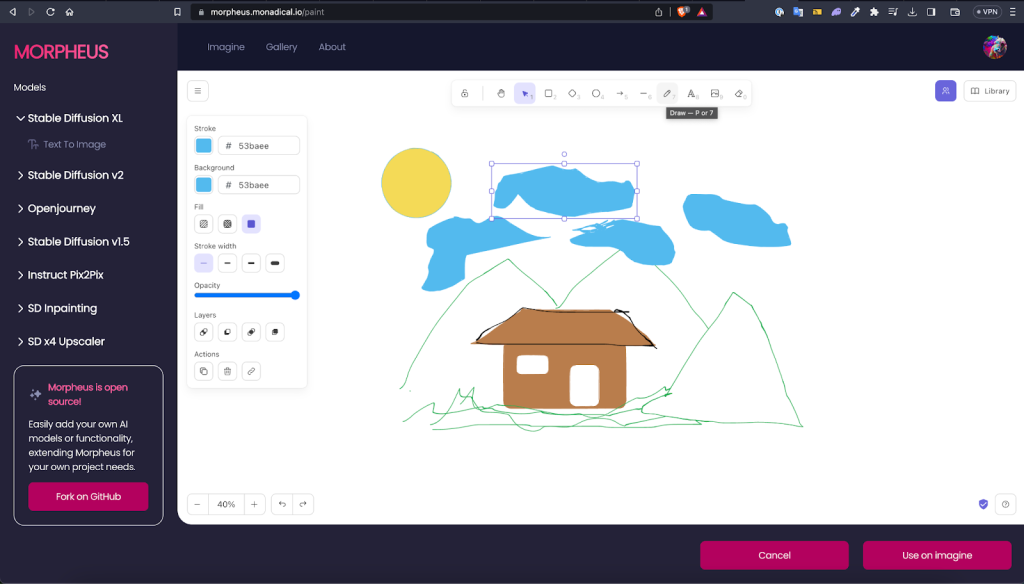
- Image Gallery Management: Morpheus includes a private image gallery where users can securely store and organize their artistic creations. Additionally, users can create image collections to group similar concepts, facilitating easy access and further editing with the assistance of AI models.
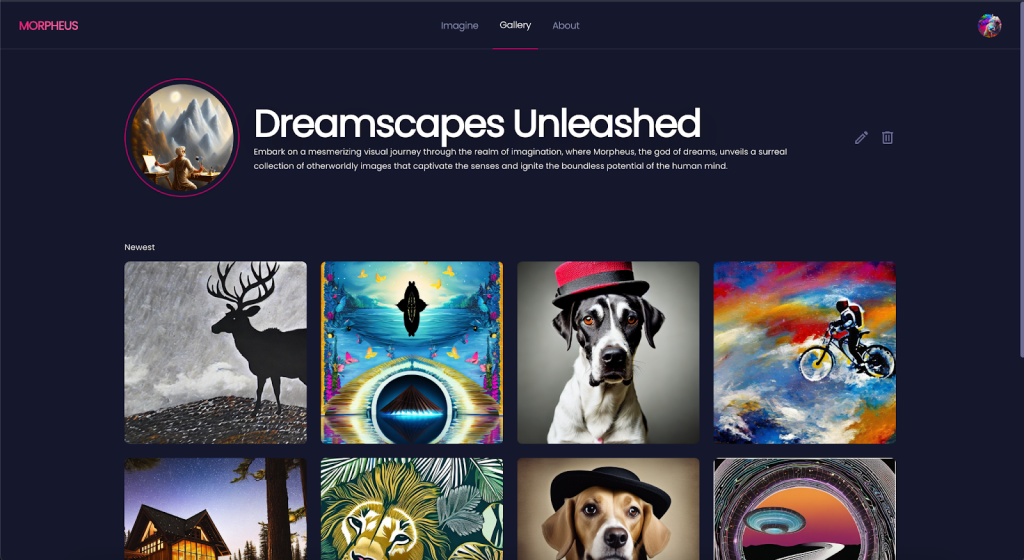
Prompt Engineering
Below are a few tips to help both students and educators get the best images from their text prompts.
- Clarity in Descriptive Prompts: use clear and descriptive prompts. Provide specific details when describing the image you want to generate or modify. Clarity in prompts helps Morpheus better understand the user’s artistic vision, resulting in more aligned creations.
- Experiment with Different Prompts: Experiment with a variety of prompts to explore diverse artistic outcomes. Slight variations in prompts can lead to significantly different results. This experimentation fosters creativity and discovery.
- Understand Model Capabilities: Each generative model within Morpheus has distinct capabilities and characteristics. Users should familiarize themselves with these models; understanding the strengths and nuances of different models allows users to make informed choices, aligning the tool with their creative objectives.
- Understand the Settings: In ‘Settings,’ users can enter negative prompts (i.e., what they don’t want to see in an image). They can also specify the number of images they want to generate (from 1-4), change the size of the images or the number of steps in the image generation process, or make other customizations. Additionally, by hovering their cursor over the “Info” icon, they get more info about each parameter.
- Incorporate Artistic Styles: Change the style of generated art by experimenting with different art styles (e.g., Impressionism, Surrealism) to achieve specific artistic effects or emulate the style of famous artists.
- Ethical Considerations: It is essential to have an understanding of the ethical dimensions of AI-generated art. Be mindful of the potential impact of their prompts on the generated content. When creating content, respect guidelines and avoid content that may be offensive or inappropriate. Be a responsible user.
- Iterative Learning Process: Using Morpheus is an iterative learning process. In other words, approach it as an opportunity for continuous improvement and exploration. Analyze the outputs critically and reflect on how different prompts influence the results. Learning from these iterations will lead to enhanced creative outcomes and a deeper understanding of the tool’s capabilities.
- Community Engagement: Consider engaging with the Morpheus user community for inspiration and insights. Connecting with others who use the tool can provide valuable tips, share experiences, and open doors to collaborative projects.
- Ongoing Exploration: The world of generative art is vast and continually evolving. Keep exploring Morpheus, experimenting with new ideas, and expanding your creative horizons.
For more on creating the perfect prompt for AI image generation, read this article.

Recommendations
- Explore Generative Art Tutorials: Delve deeper into the realm of generative art by exploring online tutorials and courses dedicated to this creative medium. These resources offer comprehensive insights into the creative process and the underlying AI technologies. Learning from experts and practitioners can enhance your artistic capabilities.
- AI Art Communities: Consider joining online communities and forums specifically focused on AI-generated art. Platforms like Reddit, Discord, or specialized art forums provide spaces for sharing, learning, and collaborating with fellow AI art enthusiasts. Engaging with a vibrant community can offer inspiration, guidance, and a sense of camaraderie.
- Art History References: Users who are intrigued by the intersection of AI and art history can explore books and articles that explore the impact of AI on the art world and its historical context. Understanding the broader art landscape enriches their appreciation of AI’s role in modern creative expression.
- Artistic Styles Catalogs: Users can explore catalogues or collections showcasing different artistic styles, including Impressionism, Surrealism, and more. Familiarizing themselves with these styles equips users with a deeper understanding of artistic aesthetics, which will aid them in refining their artistic preferences within Morpheus.
- Art and Technology Exhibitions: Consider attending local or virtual art and technology exhibitions where AI-generated art is prominently featured. These exhibitions provide real-world exposure to AI-driven creativity, offering inspiration and a broader perspective on the evolving landscape of art and technology.
- Collaborative Art Projects: Embark on collaborative art projects with friends, family, or fellow enthusiasts using Morpheus. Collaborative endeavours spark creativity and strengthen connections within the Morpheus community.
- Feedback and Improvement: The Morpheus dev team wants to hear user feedback. User insights, suggestions, and experiences are valuable contributions to the ongoing enhancement of the tool and its features.
Informative presentation
Conclusion
In conclusion, Morpheus represents not only a powerful tool for artistic expression but also a gateway to a deeper understanding of AI’s creative potential for learners in a variety of different contexts. Through its user-friendly interface, diverse generative models, and collaborative features, Morpheus encourages both novice and experienced users to embark on an exploratory and educational journey that expands traditional boundaries and notions of creativity.
References
ChatGPT. (2023). https://chat.openai.com/
Ditch That Textbook. (2023, November 13). 30 AI tools for the classroom. https://ditchthattextbook.com/ai-tools/
GitConnected. (2021, August 18). Complete guide to AI art prompt engineering. https://levelup.gitconnected.com/complete-guide-to-prompt-engineering-ab514d8a89f5/
Jodrey, H. (2023, September 26). Morpheus: A Dream Machine for AI Art Generation. Monadical. https://monadical.com/posts/morpheus-announcement.html
Lee, D., Kim, Hh. & Sung, SH. (2023). Development research on an AI English learning support system to facilitate learner-generated-context-based learning. Educational Technology Research and Development, 71, 629–666. https://doi.org/10.1007/s11423-022-10172-2
Microsoft Bing. (2023). https://bing.com/chat
Morpheus. (2023). https://morpheus.monadical.io/

Acknowledgement of AI Use
This chapter was completed with the assistance of Morpheus. Additionally, an initial rough draft was completed by brainstorming with both ChatGPT-3.5 and Bing Chat. Grammarly (free version) was also used to assist with basic spelling and punctuation conventions.

